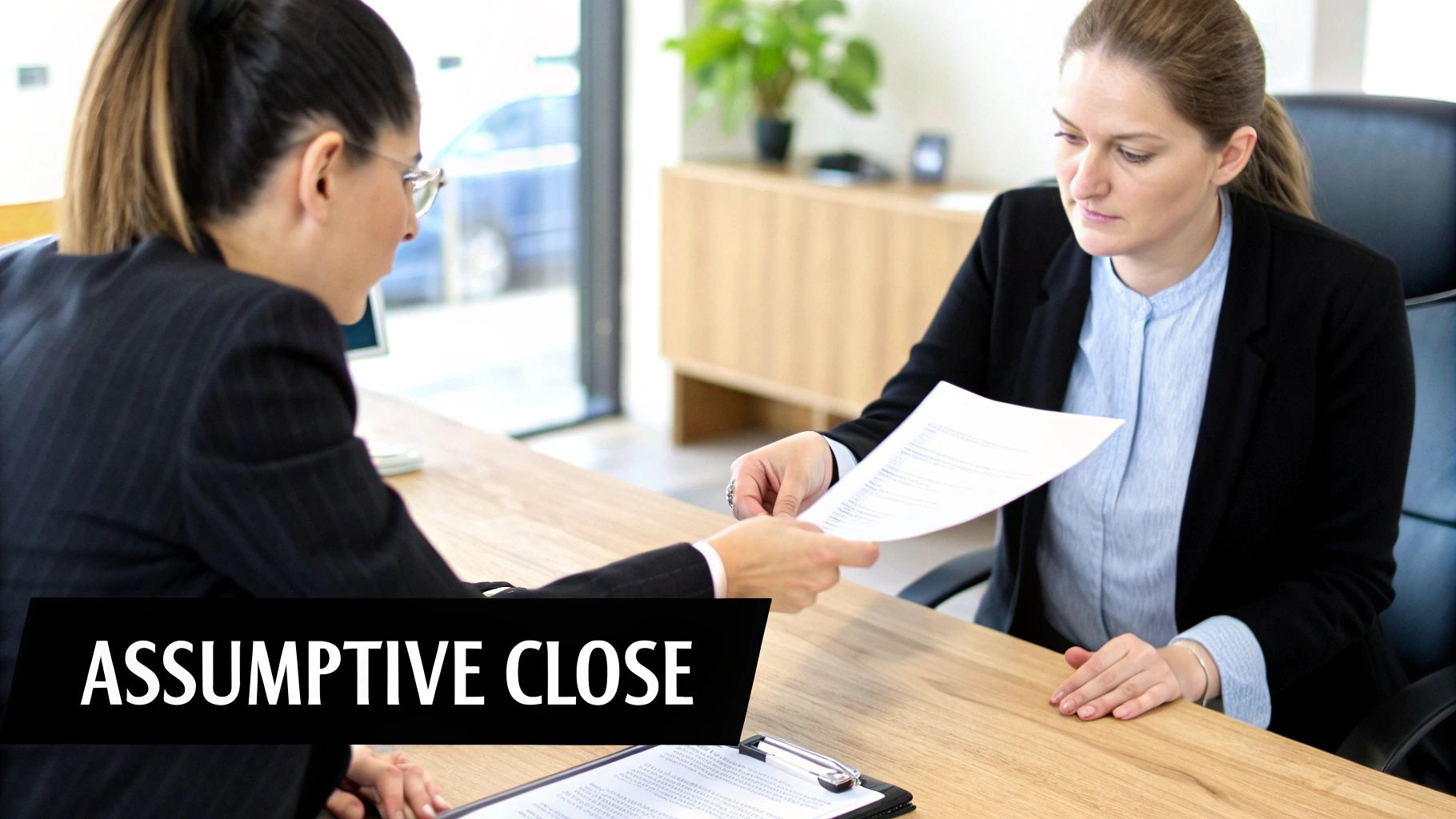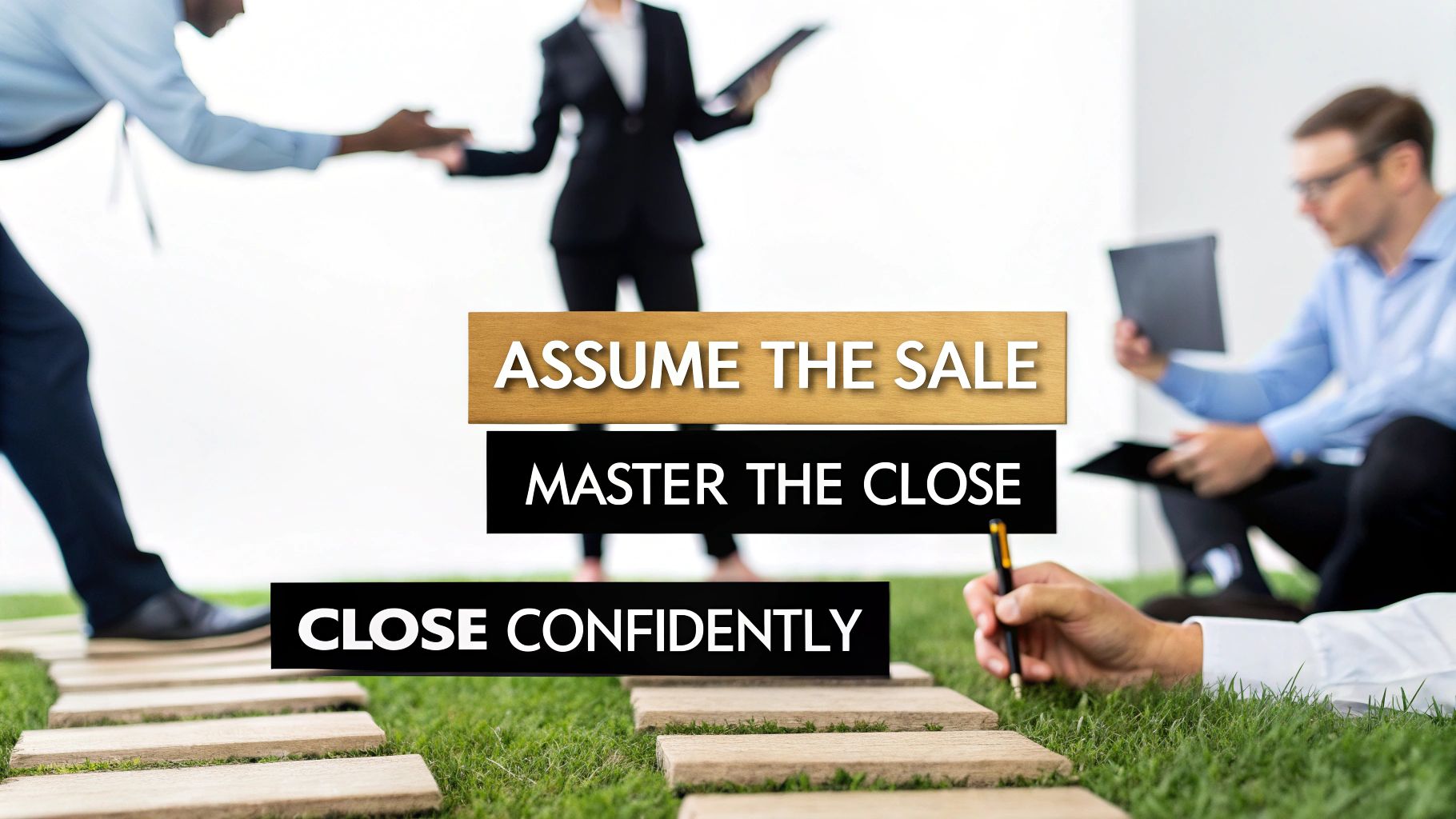Picture this: you've spent the entire sales conversation building a solid case. You've listened intently, pinpointed your prospect's exact pain points, and clearly demonstrated how your solution is the perfect remedy. They’re nodding along, asking smart questions, and showing all the right buying signals.
So, what's next? Do you ask, "So... do you want to buy it?"
That question can kill the momentum you've worked so hard to build. Instead, the assumptive close flips the script. You simply move forward as if the decision to buy is already a given. You're not asking if they want to proceed; you're discussing how.
What Is the Assumptive Close in Sales?

Think of it less as a "tactic" and more as the natural, final step of a journey you've guided your prospect on. The assumptive close in sales is a confident transition, not a pushy manoeuvre. It’s based entirely on the trust and value you've already established.
Instead of putting up one last hurdle for them to jump over, you smooth the path forward. You act like the decision has been made because, based on every positive signal you've received, it has. This subtle but powerful shift in your language and mindset can make all the difference.
The Core Idea of Assuming the Sale
At its heart, the assumptive close works on a very simple principle: if you've done your job right, the close is just a formality. It’s the difference between asking for permission and leading with conviction.
This approach is so effective because it:
- Makes the decision easier for the customer. It cuts through potential last-minute hesitation or that dreaded analysis paralysis.
- Cements your role as the expert. You're confidently guiding them toward the right solution, not just hoping they’ll buy.
- Keeps the positive momentum going. You build on the energy from your discovery calls and demos right through to the finish line.
An assumptive close helps the prospect have that "aha" moment where they realize, "Yes, this is what I need." The conversation naturally shifts from whether to buy to how to get started with a purchase they’ve already made in their mind.
This technique is a powerhouse in fast-moving sales environments where decisiveness is a huge asset. For instance, studies show the assumptive close is particularly effective in competitive retail and B2C markets. Some sales pros have even reported that using this method can boost their closing rates by 15-20% compared to older, more passive approaches. You can find more details on these findings over at MakingThatSale.com.
Assumptive Close At a Glance
To really nail this, you need to internalize its core components. It's not about memorizing lines; it's about adopting a mindset.
Here's a quick table to break down the fundamentals.
table block not supported
By mastering these ideas, the assumptive close in sales stops being just another technique in your playbook. It becomes a natural, seamless part of how you sell, leading to more consistent wins and stronger customer relationships.
The Psychology Behind Confident Closing

The power of an assumptive close in sales isn't some secret sales voodoo; it's grounded in basic human psychology. Once you get why it works, you can use it naturally, making it feel less like a tactic and more like a helpful hand guiding your customer. At its heart, this technique simply clears the clutter from the buyer's mind right when it matters most.
Think about a good doctor. After running tests and making a diagnosis, they don't ask, "So, do you feel like getting better?" No, they confidently lay out the treatment plan. That confidence isn't arrogance—it's reassurance. It tells the patient they're in good hands. A perfectly timed assumptive close does the exact same thing.
Alleviating Decision Fatigue
We're all bombarded with choices every single day. What to eat, what to watch, which software to buy for the team. It's exhausting, and this leads to a very real condition called decision fatigue. When our brains are worn out from making choices, facing one more—especially a big one—can feel like hitting a wall.
By the end of your sales process, your prospect has already said "yes" to a bunch of smaller things. They agreed to take your call, they showed up for the demo, and they answered your questions. That final "yes" can feel like the biggest mountain to climb.
The assumptive close helps them sidestep that final, exhausting decision. Instead of a big, scary "if" question, you're asking a simple "how" or "which." It’s a much easier lift for a tired mind.
This approach lightens the mental load on your prospect. You aren't twisting their arm; you're simply paving a clear, easy path to the solution they've already shown they want. It’s a subtle shift that makes a world of difference.
Leveraging the Power of Cognitive Consistency
Another powerful force at play here is our natural desire for cognitive consistency. Put simply, people need their actions to line up with their beliefs. When they don't, it creates a nagging mental itch called cognitive dissonance.
Throughout your entire conversation, you've been collecting a series of small agreements. You've confirmed their pain points and gotten nods that your solution is a great fit. Every "yes" has built a foundation, reinforcing the idea that your product is the right call.
An assumptive close builds right on top of that momentum. When you confidently start talking about next steps, like scheduling their onboarding or confirming the delivery address, you're just acting in line with everything they've already told you. For the prospect to hit the brakes and say "no" now would feel jarring and inconsistent with their own words.
- It reinforces their decision: By assuming the sale is happening, you’re telling them they've made a smart choice.
- It cuts down on buyer's remorse: This confidence helps them feel secure and prevents second-guessing later on.
- It frames you as a partner: You're not a salesperson anymore; you're a partner moving forward together.
This creates a strong psychological pull that tugs the deal across the finish line. It makes the final commitment feel like the only logical step. When you understand what’s happening in their head, your assumptive close in sales becomes a genuinely helpful tool that guides customers to a decision they can feel great about.
Reading the Signs for a Perfect Close
Using an assumptive close in sales is all about timing. Think of it like a perfectly timed punchline to a great joke—get it right, and it lands beautifully. Get it wrong, and you just get awkward silence. Jump the gun, and you risk undoing all the great rapport you’ve built.
Your success hangs on one thing: knowing how to read the room. You need to see that the prospect has already mentally said "yes" before you even pop the question. Acting without these green lights isn't confidence; it's a gamble. But when you spot the signs, it's just plain good strategy.
What to Listen For: Verbal Buying Signals
Often, the clearest signals are the ones your prospect says out loud. These aren't just polite nods; they're questions and comments that show a fundamental shift in their thinking. They’ve moved past "if" and are now deep into "how." They’re already imagining your solution as part of their world.
When you hear these, an alarm bell should go off in your head—it’s go-time.
Keep an ear out for:
- Logistical questions: "So, how quickly could we get this rolled out?" or "What does onboarding look like for a team our size?"
- Possessive language: They start using "we" and "our" when talking about the solution. For example, "This would really clear up our team's reporting bottleneck."
- Pricing specifics: "Is there a discount for paying annually?" or "What’s the total investment for a dozen licences?"
- Future-pacing: They start talking about the future with you in it. "This is going to make a huge difference for us next quarter."
These aren't just idle questions. They are direct invitations for you to lead them to the next step.
What to Look For: Non-Verbal Cues and Body Language
Sometimes, the most powerful messages are sent without a single word. In any face-to-face or video meeting, a prospect’s body language can tell you everything you need to know about their readiness to buy.
A prospect's body language often reveals their decision before they've even said it aloud. When you see them physically lean in, nod along as you make key points, or start jotting down detailed notes, you're seeing high-level engagement. They're locked in.
These actions show they aren't just listening; they're accepting what you're saying and mentally getting on board. Missing these cues means you could miss the perfect window for the assumptive close. On the flip side, trying to close someone who is leaning back with their arms crossed is just asking for a quick "no."
Your Pre-Close Checklist
Before you make your move, run through this quick mental checklist. If you can confidently tick these boxes, the stage is set for a smooth, completely natural assumptive close.
- Have you handled all objections? You’ve answered their big questions and cleared away any major doubts.
- Do they get the value? The prospect has openly acknowledged how your solution fixes their specific problem.
- Is there real rapport? The conversation feels less like a sales pitch and more like a collaborative partnership.
- Have you seen multiple buying signals? You’ve noticed a mix of the verbal and non-verbal cues we just talked about.
Once these conditions are met, the assumptive close stops feeling pushy. It becomes the most logical and helpful way to end a great conversation, cementing your role as the trusted advisor who guided them to a solution they already decided they want.
Assumptive Close Scripts That Actually Work
Knowing the theory behind the assumptive close is a good start. But where the rubber really meets the road is in knowing exactly what to say. The wrong words can sound pushy or robotic, completely backfiring on you. The right words, however, feel like a natural, helpful next step.
This isn't about using Jedi mind tricks. It's about having a playbook of genuine, context-aware phrases that guide a prospect who's already signalling they're ready to move forward. You’re simply transitioning the conversation from "if" to "how."
After a Great Product Demo
You just wrapped up a demo. The prospect was leaning in, asking great questions, and you can feel the momentum. Now is the time to steer the conversation toward what comes next.
Here are a few ways to do that:
- "Based on what you've shown me, the Premium tier seems to tick all the boxes for your team. Which email should I send the setup link to?" This works because you’re reaffirming the value you just demonstrated and immediately following up with a simple, logical question.
- "This looks like a perfect fit. To get you started, should we schedule your team’s onboarding session for this Tuesday, or would Thursday be better?" A classic. You’re not asking if they want to onboard; you’re asking when. It's a choice between two "yes" scenarios.
- "I'll get the agreement drafted. In the meantime, who on your team will be the main point of contact for the implementation?" This phrase projects confidence. You're moving ahead with the paperwork while gathering key details, making the entire process feel collaborative.
During Contract and Pricing Talks
Once you're hashing out the details of a contract, the prospect is already deep in the buying process. Your language should mirror that reality by focusing on the specifics of your new partnership.
"To make sure we get this processed smoothly for a start date of the 1st, what's the best way to get this in front of your finance department?"
This is a fantastic line because it assumes their ideal start date is a done deal. You’re positioning yourself as a partner who is helping them navigate their own internal hoops to get things done on their timeline.
For field sales managers, this stage is crucial. As we've covered in our guide on door to door sales, closing deals efficiently has a massive ripple effect on territory performance and team morale.
This infographic lays out just how much a confident, assumptive approach can stack up against more hesitant methods.

As you can see, it's not just about closing more deals. It’s about shortening the sales cycle and even boosting customer satisfaction along the way.
For High-Ticket Items (Like Automotive Sales)
When the stakes are higher and the product is a major purchase, your assumptive close needs a bit more finesse. Take California's automotive industry—a massive part of the provincial economy where every sale counts. With new vehicle registrations dipping slightly, dealerships are looking for every possible edge.
Interestingly, the dealers seeing the best results are those confidently assuming the sale, especially with electric vehicles (EVs), where sales jumped by over 21.4%. They skillfully bypass common roadblocks around price and charging anxiety. For a closer look, you can explore the full report from the California New Car Dealers Association.
Here’s how that sounds on the showroom floor:
- "While we get the paperwork started, would you like us to top up the charge? Or I can show you how the home charging station works." This offers immediate, tangible value. It makes the purchase feel real right now.
- "Which address should we use for the vehicle registration—the one on your driver’s licence?" A simple, low-pressure question. You're just handling a routine administrative step, which naturally moves the process forward.
- "Let's go ahead and schedule your first service appointment. We have openings next month on the 15th or the 18th." By planning for the future, you reinforce the long-term value of ownership and make their decision to buy today feel even more solid.
Mistakes That Can Derail Your Close
There's a razor-thin line between confidence and cockiness when you use the assumptive close in sales. Nail it, and you come across as a helpful expert, guiding a client toward the right decision. But get it wrong, and you can torpedo all the rapport you've spent hours—or even weeks—building.
Honestly, knowing what not to do is just as critical as memorizing the right lines. Dodging these common mistakes is what makes the assumptive close feel like a natural next step instead of a clumsy, high-pressure tactic.
Misreading the Room
The single biggest mistake? Jumping the gun. Confidence is key, but it has to be earned. It must be built on a solid foundation of buying signals from the prospect. If you haven't seen those signals, you're not assuming the sale—you're just guessing.
Trying to force an assumptive close when a prospect is clearly still on the fence or has unanswered questions is a surefire way to get a hard "no." It basically screams, "I haven't been listening to you."
- DON'T: Hit them with "So, which delivery address should I use?" right after they’ve said, "I'm still not sure how this integrates with our current software."
- DO: Tackle their concern head-on. Wait until they say something like, "Okay, that makes sense. The integration seems pretty straightforward," and then you can smoothly transition to the close.
Adopting a Pushy Tone
How you say it matters just as much as what you say. Your tone and body language can make or break the moment. An assumptive close needs to be delivered with a calm, collaborative confidence, not aggressive impatience.
If you sound demanding, you'll immediately put the prospect on the defensive. It's human nature.
Think of yourself as a helpful partner tying up the loose ends, not a salesperson rushing to get a signature. Your whole vibe should communicate, "We're on the same team here."
A successful assumptive close hinges on mutual understanding. When you move to the closing steps, it should feel like you're confirming a decision the prospect has already made, not pressuring them into one they haven't.
If you find that your deals are consistently getting stuck right at the finish line, the problem might actually be happening way earlier. It could be an issue with how leads are qualified and handed off. For a closer look, check out our guide on lead routing best practices to boost sales efficiency.
